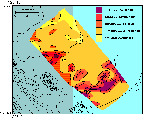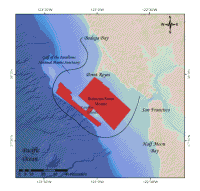
The Gulf of the Farallones: Sidescan-Sonar Imagery, USGS Open-File Report 2004-1082
|
Home Page Mosaic & Explanation GIS Data Contacts About this Disk |
IntroductionClick on figures for larger view.
In 1989, the U.S. Geological Survey (USGS) began a major geologic and oceanographic investigation of the Gulf of the Farallones National Marine Sanctuary continental shelf system (Figure 1), designed to evaluate and monitor human impacts on the marine environment (Karl and others, 2002). The study region is located off the central California coast, adjacent to San Francisco Bay and encompasses the Gulf of Farallones Marine Sanctuary. Geologic mapping of this area included the use of various remote sensing and sampling techniques such as shallow sub-bottom profiling, sidescan-sonar and bathymetric mapping, gravity core and grab sampling, and photography. These data were used to define the surficial sediment distribution (Figure 2), underlying structure and sea floor morphology of the study area.
The primary focus of this report is to present a georeferenced, digital sidescan-sonar mosaic of the study region. The sidescan-sonar data were acquired with the AMS-120 (120 kHz) sidescan-sonar system during USGS cruise F9-89-NC. The dataset covers approximately 1000 km² of the continental shelf between Point Reyes, California and Half Moon Bay, California, extending west to the continental shelf break near the Farallon Islands (Figure 3). The sidescan-sonar mosaic displays a heterogenous sea-floor environment, containing outcropping rock, ripples, dunes, lineations and depressions, as well as flat, featureless sea floor (Karl and others, 2002).
To view files in PDF format, download free copy of Adobe Reader http://www.adobe.com/products/acrobat/alternate.html. |
Home Page / Mosaic & Explanation / GIS Data / Contacts / About this Disk
[an error occurred while processing this directive]


